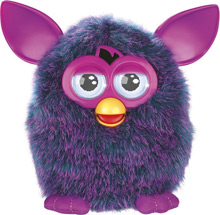
Furby is an American electronic robotic toy by Tiger Electronics. Originally released in 1998, it resembles a hamster or owl-like creature and went through a period of being a "must-have" toy following its holiday season launch. Over 40 million Furbies were sold during the three years of its original production, with 1.8 million sold in 1998, and 14 million in 1999. Its speaking capabilities were translated into 14 languages.

LeapFrog Enterprises, Inc. is an educational entertainment and electronics company based in Emeryville, California. LeapFrog designs, develops, and markets technology-based learning products and related content for the education of children from infancy through grade school. The company was founded by Michael Wood and Robert Lally in 1994. John Barbour is the chief executive officer of LeapFrog.

The Speak & Spell line is a series of electronic hand-held child computers by Texas Instruments that consisted of a TMC0280 linear predictive coding speech synthesizer, a keyboard, and a receptor slot to receive one of a collection of ROM game library modules. The first Speak & Spell was introduced at the summer Consumer Electronics Show in June 1978, making it one of the earliest handheld electronic devices with a visual display to use interchangeable game cartridges. The company Basic Fun brought back the classic Speak & Spell in 2019 with some minor changes.

Playskool is an American brand of educational toys and games for children. The former Playskool manufacturing company was a subsidiary of the Milton Bradley Company and was headquartered in Chicago, Illinois. Playskool's last remaining plant in the aforementioned city was shut down in 1984, and Playskool became a brand of Hasbro, which had acquired Milton Bradley that same year.
The long-running British science fiction television series Doctor Who has since its beginnings in 1963 generated many hundreds of products related to the show, from toys and games to picture cards and postage stamps. This article is not an exhaustive list of merchandise but attempts to present a flavour of the type of material that has been produced. This entry mainly concentrates on "official" spin-offs, that is to say, material sanctioned by the British Broadcasting Corporation, which produces the series.

2-XL is an educational toy robot that was marketed from 1978–1981 by the Mego Corporation, and from 1992–1995 by Tiger Electronics. 2-XL was the first "smart-toy" in that it exhibited rudimentary intelligence, memory, gameplay, and responsiveness. 2-XL was infused with a "personality" that kept kids focused and challenged as they interacted with the verbal robot. Learning was enhanced via the use of jokes and funny sayings as verbal reinforcements for performance. 2-XL was heralded as an important step in the development of toys, particularly educational ones. 2-XL won many awards, and Playthings, a toy industry magazine, placed 2-XL on its 75th anniversary cover as one of the industry's top-ten toys of all time. The 2-XL name is a pun of the phrase "to excel".

The Playroom is an educational video game published in 1989 for MS-DOS, Apple II, and Mac. The game was compatible with the TouchWindow utility. It was ported to the Amiga and FM Towns computers in 1992 and 1994 respectively and then remade for Microsoft Windows and Macintosh in 1995. It was designed for ages 3 to 6 manufactured by Broderbund. A follow-up game titled The Treehouse came in 1991 as well as a sequel to this game, called The Backyard in 1993.
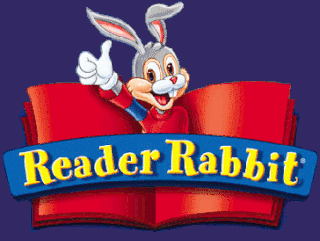
Reader Rabbit is an educational video game franchise created in 1984 by The Learning Company. The series is aimed at children from infancy to the age of nine. In 1998, a spiritual successor series called The ClueFinders was released for older students aged seven to twelve.
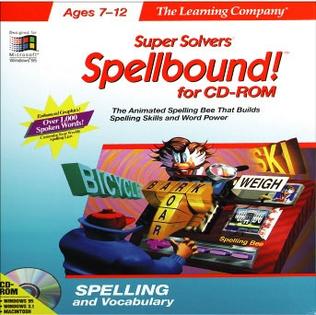
Spellbound! is an educational computer game made and distributed by The Learning Company aimed at teaching spelling, vocabulary, and language development to children ages 7 to 12 years. The objective of the game is to play spelling-related games to qualify and compete for successively higher bracket spelling bees, concluding with the player competing in the national spelling bee. The original game, released in 1991, was compatible with computers running DOS 3.3 or higher. A 1993 CD release added spoken dialogue and was compatible with Windows 95 and Macintosh.

Educational toys are objects of play, generally designed for children, which are expected to stimulate learning. They are often intended to meet an educational purpose such as helping a child develop a particular skill or teaching a child about a particular subject. They often simplify, miniaturize, or even model activities and objects used by adults.
A smart toy is an interactive toy which effectively has its own intelligence by virtue of on-board electronics. These enable it to learn, behave according to preset patterns, and alter its actions depending upon environmental stimuli and user input. Typically, it can adjust to the abilities of the player. A modern smart toy has electronics consisting of one or more microprocessors or microcontrollers, volatile and/or non-volatile memory, storage devices, and various forms of input–output devices. It may be networked together with other smart toys or a personal computer in order to enhance its play value or educational features. Generally, the smart toy may be controlled by software which is embedded in firmware or else loaded from an input device such as a USB flash drive, Memory Stick or CD-ROM. Smart toys frequently have extensive multimedia capabilities, and these can be utilized to produce a realistic, animated, simulated personality for the toy. Some commercial examples of smart toys are Amazing Amanda, Furby and iDog. The first smart-toy was the Mego Corporation's 2-XL robot (2XL), invented in the 1970s

My French Coach and My Spanish Coach are educational games developed by Sensory Sweep Studios and published by Ubisoft for the Nintendo DS, iOS, PlayStation Portable, and Wii. They are part of Ubisoft's My Coach series, and were released for the Nintendo DS on November 6, 2007 in North America, for the Wii on November 23, 2007 in Europe, and My Spanish Coach was released for the PlayStation Portable on October 7, 2008, and iOS on June 6, 2009. For their releases in Europe and Australia, the games were renamed My French Coach Level 1: Beginners and My Spanish Coach Level 1: Beginners.
There have been a variety of Sesame Street video games released for video game platforms. Most of the Sesame Street video games were published and developed by NewKidCo.
Lego Education, formerly known as Lego Dacta, is a specialized Lego theme created for educational purposes in schools. This theme, introduced in 1999, includes a variety of sets that cater to different educational needs.[2] These sets often focus on Duplo and Technic themes and typically contain a larger quantity of blocks. By incorporating these sets into the classroom, educators can provide students with hands-on learning experiences that enhance their understanding of various subjects, from basic building concepts to advanced engineering principles.[1]
Learning through play is a term used in education and psychology to describe how a child can learn to make sense of the world around them. Through play children can develop social and cognitive skills, mature emotionally, and gain the self-confidence required to engage in new experiences and environments.

Tekno the Robotic Puppy is a popular electronic robotic toy which originally launched in late 2000. Tekno sold more than 7 million units in its first season and went on to sell more than 40 million units in its original 4 years of production. The worldwide popularity for Tekno led to prominent awards and widespread media coverage which included newspaper articles, television and film appearances, and a stand-alone feature on the cover of Time magazine.
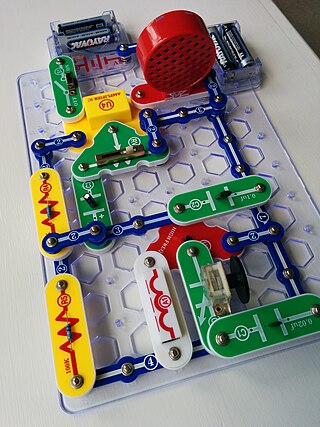
Snap Circuits is a line of electronic kits manufactured by Elenco Electronics and aimed at children eight years and older. The kits come in a variety of sizes, and may include capacitors, diodes, electric motors, lamps, LEDs, radios, electromagnets, speakers, resistors, transformers, transistors and voltmeters. The kits contain a plastic baseboard into which the various components and wires can be snapped to easily create a working circuit. Snap Circuits was first released in 2002.

Kasey the Kinderbot is an educational toy learning system designed, developed, and sold by Fisher-Price, a wholly owned division of the Mattel Corporation, nominated for the Educational Toy of the Year award in 2002. Because of its strong commercial sales, Kasey was reported as an important item in the balance sheet of Fisher-Price.
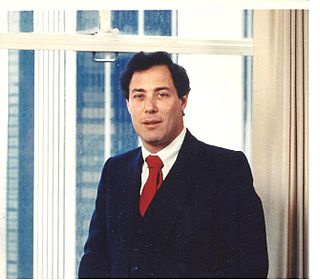
Michael J. Freeman is an American inventor who works in trend analysis, advanced behavioral systems, programming of smart toys, cable television and robotics. He was a professor at three American universities and a consultant to business and governments.
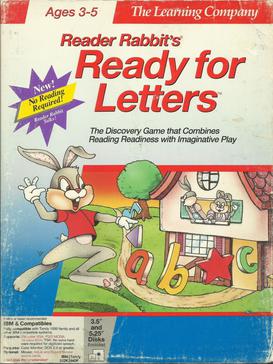
Reader Rabbit's Ready for Letters is a 1992 video game and the fifth game of the Reader Rabbit franchise. Although a spin-off title, it is designed for ages 3 to 6 to teach prereaders about becoming literate and phonics.
















